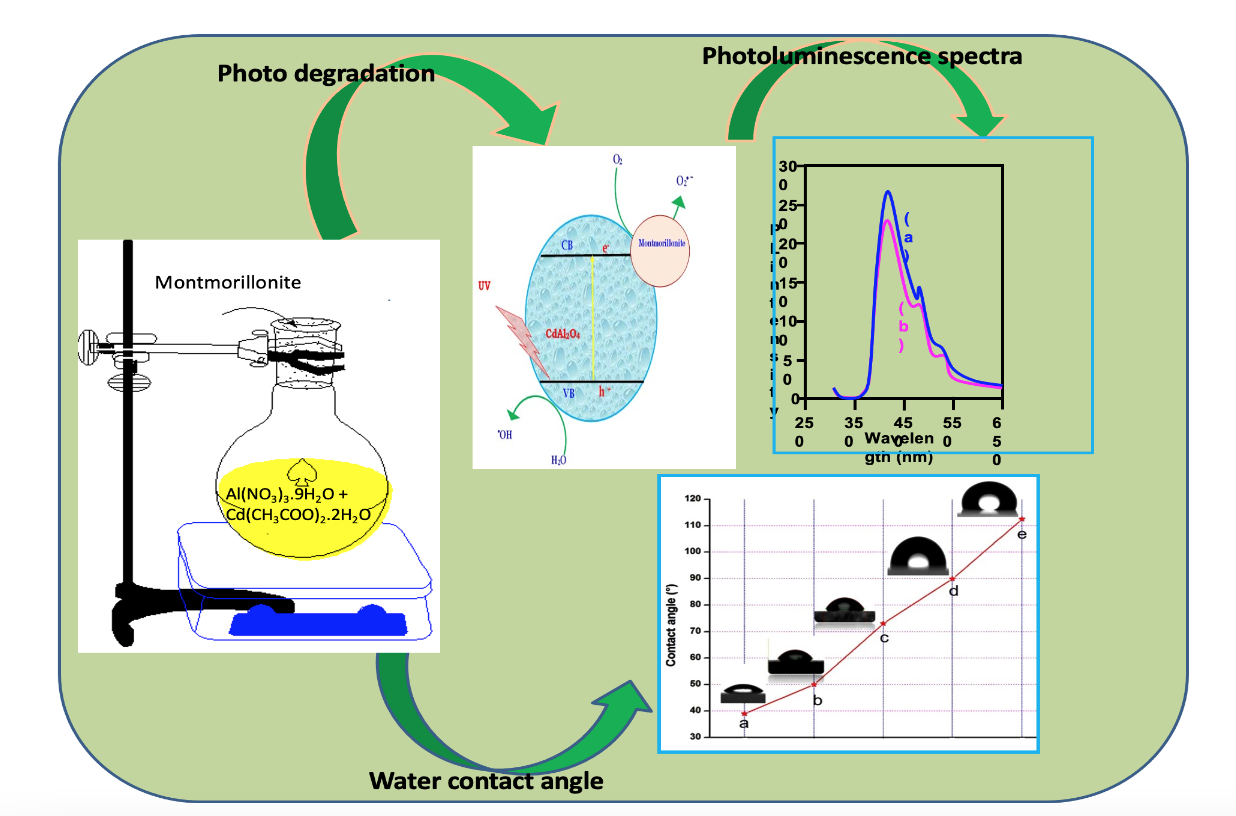A Facile Synthesis of Montmorillonite Supported CdAl2O4 Nanocomposites with Photocatalytic and Hydrophobic Properties

Published 2025-03-04
Keywords
- Montmorillonite clay,
- CdAl2O4 nanoflakes,
- Rhodamine-B,
- Contact angle,
- Photodegradation
How to Cite
Copyright (c) 2025 Kumar Rajathi, Kalpana

This work is licensed under a Creative Commons Attribution 4.0 International License.
Abstract
The hydrothermal co-precipitation method was successfully employed to synthesize CdAl2O4 supported by natural clay, montmorillonite to reduce the toxicity of solid and liquid wastes that cause serious harm to livestock and humans due to the discharge of dye wastes into water bodies. Characterization of the montmorillonite/CdAl2O4 (MMT/CdAl2O4) composite was carried out using various techniques, including X-ray powder diffraction (XRD), scanning electron microscopy (SEM), high-resolution transmission electron microscopy (HR-TEM), photoluminescence spectroscopy (PL), diffuse reflectance spectroscopy (DRS), and BET surface area analysis. Experimental results indicate that CdAl2O4 supported by montmorillonite at a 9% wt concentration exhibited superior photocatalytic activity compared to undoped CdAl2O4 in the removal of the azo dye rhodamine-B (rh-B) under solar light irradiation. The FE-SEM images clearly reveal the formation of nanoclusters and nanoflakes interconnected via edge-to-flat-surface conjunction. Furthermore, BET analysis demonstrated that the surface area of MMT/CdAl2O4 surpasses that of undoped CdAl2O4. Remarkably, montmorillonite-supported CdAl2O4 exhibited excellent photocatalytic activity for up to four consecutive uses. A notable feature of montmorillonite/ CdAl2O4 is its high hydrophobicity, as evidenced by a contact angle of 113.8°. This hydrophobic nature is particularly advantageous in the production of self-cleaning materials.
References
- S. Boudiaf, N. Nasrallah, M. Mellal, C. Belabed, B. Belhamdi, D. Meziani, M. Trari, Optik 2020, 219, 165038.
- G. Wu, W. Wang, L. Cai, Y. Hong, Y. Jiang, C. Wang, React. Kinet. Mech. Cat. 2016, 119, 523-535.
- J. Li, S. Wang, G. Sun, H. Gao, X. Yu, S. Tang, Y. Wei, Mater. Today Chem. 2021, 19, 100390.
- X. D. Hou, X. Q. Guan, Y. F. Cao, Z. M. Weng, Q. Hu, H. B. Liu, J. Hou, Int. J. Biol. Macromol. 2020, 145, 620.
- G. Panthi, O. H. Kwon, Y. S. Kuk, K. R. Gyawali, Y. W. Park, M. Park, Catalysts 2020, 10, 348.
- H. Fan, X. Zhao, J. Yang, X. Shan, L. Yang, Y. Zhang, Catal. Commun. 2012, 29, 29-33.
- M. Bahrami, A. Nezamzadeh Ejhieh, Mater. Sci. Semicond. Process 2015, 30, 275-284.
- K. Thirumalai, S. Balachandran, M. Swaminathan, Materials Chemistry and Physic 2016, 183, 191-200.
- N. Nadeem, M. Zahid, Z. A. Rehan, M. A. Hanif, M. Yaseen, International Journal of Environmental Science and Technology 2021, 19, 3045-3060.
- K. Thirumalai, E. T. Deva Kumar, R. Aravindhan, J. Raghava Rao, and M. Swaminathan, Surfaces and Interfaces 2016, 5, 30-38.
- G. K. Zhang, X. M. Ding, F. S. He, X. Y. Yu, J. Zhou, Y. J. Hu, J. W. Xie, Langmuir 2008, 24 (3), 1026-1030.
- M. Mylarappa, N. Raghavendra, N. R. Bhumika, C. H. Chaithra, B. N. Nagalaxmi, K. N. Shravana Kumara, Chem.Phys.Mater. 2023, 3, 83-93.
- M. Mylarappa, N. Raghavendra, B. S. Surendra, K. N. Shravana Kumar, S. Kantharjau, Applied Surface Science Advances 2022, 10, 100268.
- M. Mylarappa, S. Chandruvasan, B. Thippeswamy, K. N. Shravana Kumara, S. Kantharaju, Sustainable Chemistry for the Environment 2023, 2, 100007.
- F. Uddin, j. intech. open 2018, 77987.
- H. Liang, Z. Wang, L. M. Liao, L. Chen, Z. Li, J. Feng, Optics. 2017, 136, 44-51.
- I. Fatimah, T Huda, Applied Clay Science 2013, 74, 115-120.
- N. Yaghmaeiyan, M. Mirzaei, R. Delghavi, Results in Chemistry 2022, 4, 100549.
- K. G. Bhattacharyya, S.S. Gupta, Adv. Colloid Interface Sci. 2008, 140, 114.
- K. Fuminao, W. Toru, and O. Tatsuya, ACS Appl Mater Interfaces. 2020, 12(6), 7021-7029.
- Karthika, V. Srivastava, E3S Web of Conferences 2023, 453, 01058.
- P.R. Ashok, S. Grigorly, B. Subhash, Current Pharmaceutical Biotechnology 2021, 22(6), 773-792.
- A. Bouhemadou, F. Zerarga, A. Almuhayya, S. Bin-Omran, Mater. Res. Bull. 2011, 46 (12), 2252-2260.
- L. K. Kurihara, S. L. Suib, Chem. Mater 1993, 5(5), 609-613.
- A. Manzar, G. Murtaza, R. Khenata, M. Yousaf, S. Muhammad, Hayatullah, Chin. Phys. Lett. 2014, 31(6), 67401-67404.
- Z. Lv, Q. Chen, Y. Guo, Solid State Sciences 2020, 109, 106393.
- R. Kumar, M. A. Barakat, B. A. Al Mur, F. A. Alseroury, J. O. Eniola, J. Clean. Prod. 2020, 246, 119076.
- Y. Ma, W. Ran, J. Alloys Compd. 2020, 842, 155787.
- G. Rajesh, P. Senthil Kumar, R. Gayathri, S. Akilandeswari, Mandal, A. Aindrila, V. Uma Shankar, M. Ramya, K. Nirmala, K. Thirumalai, Mol. Catal. 2023, 535, 112835.
- A. Rafiq, M. Ikram, S. Ali, F. Niaz, M. Khan, Q. Khan, M. Maqbool, Journal of Industrial and Engineering Chemistry 2021, 97, 111-128,
- W. Ran, L. Wang, Q. Liu, G. Liu, D. Qu, X. Pan, J. Shi, RSC Adv. 2017, 7, 17612.
- P. Rajesh, P. Senthil Kumar, S. Akilandeswari, G. Rangasamy, S. Lohita, V. Uma Shankar, M. Ramya, K. Thirumalai, Chemosphere 2023, 32, 138232.
- T. Watanabe, T. Sato, Clay Sci. 1988, 7, 129-138.
- S. Mahalaxmi, G. Rajesha, P. Senthil Kumara, S. Akilandeswari, M. Arul Joshua, V. Uma Shankar, M. Ramya, K. Thirumalai, R. Gayathri, Chemosphere 2023, 322, 138178.
- V. Maja, L. Mika, L. Kai, H. Tommi, H. A. R. Ras, Soft Matter 2019, 15, 7096.




